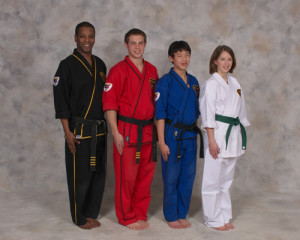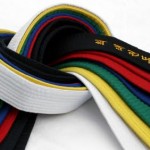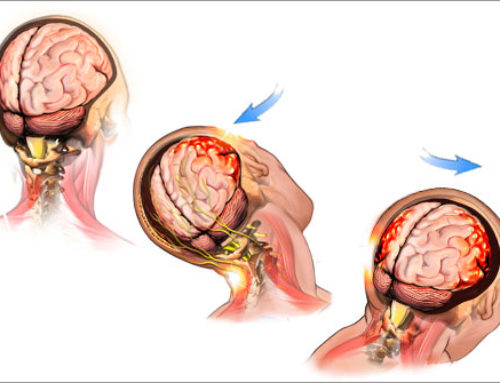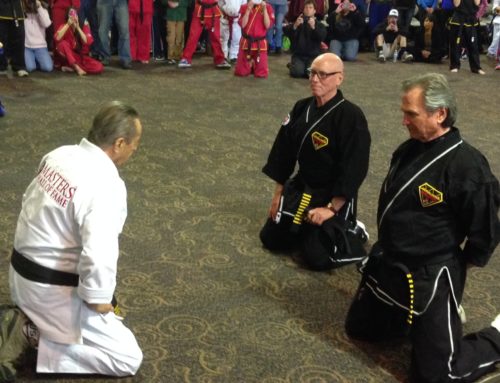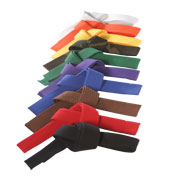
National Karate instructors stress that self-defense skills must never be misused or abused. Our school motto is ‘Might for Right,’ which means our karate is our Might and is only used for the Right reasons.
Traditional Commands:
- Charyo (CHAR-ee-oh)-Attention: Feet together, hands firmly to the side.
- Chunbi (CHOON-bee)-Ready: Stand with outside edge of feet parallel, inside edge of feet spaced shoulder width apart; place fists one inch apart and one inch in front of belt knot.
- Goman (Goh-MAHN)-End: Same position as Chunbi.
- Keyunge (Key-YOUNG-yea)-Salute: Stand with feet together, bend forward at the waist to a 45 degree angle, eyes look down.
- Shio (Show)-At ease: Feet shoulder width apart, hands behind back.
Basic Karate Techniques for Beginners:
- Fighting Stance: Feet form an ‘L,’ are shoulder width apart back to front, and 1 to 2 inches side to side with both knees flexed. Most of the weight is on the back leg. Front fist mouth level with elbow bent 90 degrees, rear fist covering solar plexus.
- Backfist: Snapping motion, striking with the back of the first two knuckles of the front hand.
- Punch: Twist the back foot and hip to transfer body weight forward, striking with the front of the first two knuckles of the rear hand.
- Front Kick: Upward snapping motion, striking with the top of the foot.
- Side Stomp: Large vertical knee motion; locking the leg down, striking with the heel.
Belt Testing & Dress Code
Testing for all students under black belt happens in the karate school. Children (ages 4-7) do their promotions in class. Youth and adult students have a special test day at their school that they are required to participate in to advance. Students are invited to attend exams by their head instructors. Announcements for testing day are posted in the school and announced in class by thier instructors. Students demonstrate techniques specific to your rank. Some techniques are performed individually and some are performed as a group. The exam concludes with the instructor tying on the new rank of students who were able to perform their belt level curriculum correctly. Exam days are fun and exciting days at the karate schools. Family and friends are welcome to attend. Families are encouraged to take photos and video of the testing process.
Uniform & Belts
At National Karate you will see a great number of different uniforms and belt colors. Each uniform and belt conveys information to those who know how to
‘read’ them.
Below you will find a list describing the differences of the uniforms and belts.
THE UNIFORMS:
Plain white: The basic student uniform. It should have a round NK patch sewn onto the left chest. Everyone gets this uniform when they begin training.
White with Red piping: Full dress uniform. Students who want their name on a uniform, but have not enrolled in a program that provides a lettered uniform may purchase one.
White with Black piping: The Black Belt Club uniform. A student who has made the commitment to reach Black Belt receives one of these uniforms as part of their program.
Blue with Red piping: The Masters Club uniform. This uniform is for students who have made the commitment to continue training after they reach Black Belt.
Blue with Black piping: The First Degree Black Belt uniform. This is the first uniform that signifies a person’s rank.
Red with Gold piping: The Second Degree Black Belt uniform. Black Belts who continue to train and improve, move up in rank and receive a new uniform.
Red with Black piping: The Third Degree Black Belt uniform. Obviously similar to the second degree, but distinct enough to be recognized for the extra effort it represents.
Black with Gold piping: The Fourth Degree Black Belt uniform. Only the most dedicated ever reach this rank. The coveted black uniform signifies deep knowledge of the martial arts.
Black with Silver piping: The Grandmaster uniform. Only two people in National Karate wear this special uniform, Mr. John Worley and co-founder Larry Carnahan.
THE BELTS:
National Karate has three sets of ranks:
The children’s ranks, youth and adult ranks, and black belt degrees.
Children: The ranks for children (ages 4 to 7 years old) are all white belts. Some of the belts have either one or two colored ribbons (called stripes) sewn onto them. The color sequence is Gold, Green, Purple, Blue, Red, Brown and Black. Rank order is by color sequence first, then number of stripes. Instructors give promotions for these ranks in class.
Youth & Adult: The youth (ages 8 to 12 years old) and adults all start out without a belt and must earn their first rank of white belt. The color sequence is the same as the children’s ranks, White, Gold, Green, Purple, Blue, Red, Brown and Black. Starting at Blue, each successive belt alternates between a solid belt and a belt with a stripe the color of the next in the sequence. Instructors periodically place pieces of colored tape on tip of the belts to signify progress towards the next rank. An exam is held monthly for all students who are eligible for the next level. Students are invited by their instructor to participate in the exam when they are ready for the next rank.
Black Belt: Once a person receives a Black Belt (with a blue and black uniform), they are a first degree. You may notice that one end of their belt has one gold stripe sewn onto it. As they progress towards a new rank, their instructors give them a gold star shaped patch to attach to the lapel of their uniform. After they have earned enough stars (3), the student is ready to test for advancement to the next degree. Once they have successfully completed the test, the student receives a new uniform and a belt with an additional stripe sewn on. An easy way to know a Black Belt’s degree is to count the number of stripes on their belt.
The average training time to earn a 1st Degree Black Belt is 3 years. From 1st Degree to 2nd Degree is a minimum of 2 years of continued training. To move from 2nd to 3rd Degree is another 3 years of advanced training. 3rd to 4th Degree is another 4 years. 4th to 5th Degree is another 5 years and so on. 10th Degree is the highest level of Black Belt in the martial arts. Our founders, Grand Master John Worley and Grand Master Larry Carnahan are both 10th Degree Black Belts. There are only a dozen or so true 10th Degree Black Belts in the United States.

